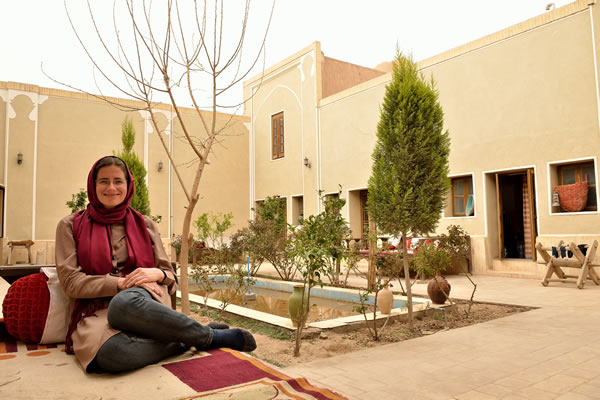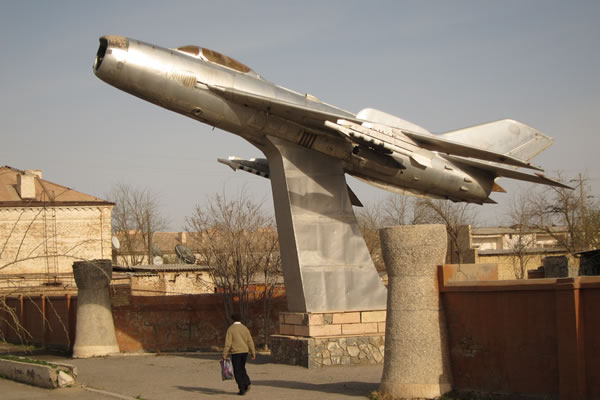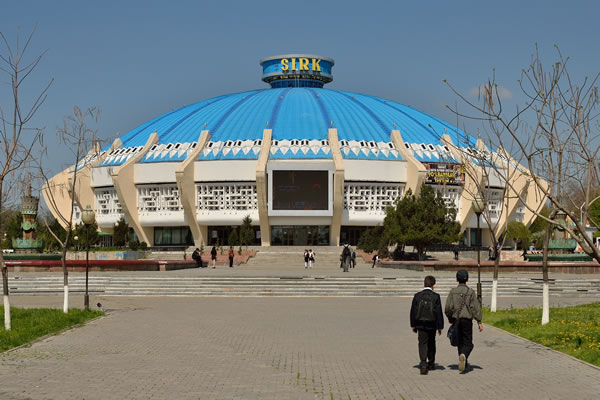English | Dutch |
|
| On our way to Central Asia | |
Shiraz (Iran) to Tashkent (Uzbekistan), March 2013
|
|
| |
|
With the extended Iranian visa in our possession, we left Shiraz again. The highways and roads in Iran are in perfect condition and also the quality of the Volvo and Scania busses are great. So, a comfortable journey of around five hours took us from Shiraz to the old desert town Yazd. Yazd is one of world’s oldest cities; at least that is what UNESCO says. The town, whose centre is a maze of small lanes with mud-brick walls and buildings, is a place where it is easy to get lost. We decided to stay in a small traditional hotel in the heart of the old town, and explore the city from here. But things have changed in Yazd. During our first visit to the city in 1998, we mainly saw old men, women and donkeys in the small alleys of the old town. But today, they are replaced by small cars and young men on fast motorcycles. After a week we left again, now with Iran’s holiest city Mashad as destination. Day buses aren’t usual on this route so we were forced to take a night bus. And that is something we always try to avoid. But once in a while this isn’t possible. The bus ride of fifteen hours took us through Iran’s central desert. When the sun came up, we saw that the desert was covered with snow. Mashad is for Shiites a very holy place because their eighth Imam (Reza) has been buried here in an impressive shrine. When visiting the shrine, you have to dress respectfully and women have to wear a chador. We were accompanied by Hooda, a guide who showed us around to point out all the interesting places. This very friendly young lady invited us for the next day to have lunch at her place in a suburb of Mashad. In Iran it is custom to decline a few times, before accepting such a generous offer but Hooda insisted and we had a great time with lovely company and delicious food at her place. Mashad is also the city where we collected our Turkmen transit visa. We already applied for the visa in Tehran, so we could pick it up at the consulate directly after we arrived in Mashad. Another thing that sometimes has to be done is changing the lenses of our glasses. Mashad appeared to be a very economical place to do so: for 10 Euro per pair of lenses, we can see clearly again! |
|
 |
|
Slaughter garbage in the back of a Paykan (Iranian car make) in Yazd |
|
A few days before Iranian New Year (No Ruz) we left Iran and crossed the border to Turkmenistan (see also the article of the border crossing). Unfortunately, we only have a visa for 5 days, because Turkmenistan doesn’t want too much foreign influences. This means that they don’t want to see many tourists and if you want to visit the country for a longer time, a guide is compulsory. Ever since the Soviet Union fell apart, the country has been governed by dictators who are frantic about everything foreign. Five days is very short, but enough to get a global impression of the country. It is certainly one of the strangest countries that we visited so far. Never have we seen such an obvious “police state” being visible in every street. Ashgabat, the capital, exists for a large part of marble government buildings. Portraits and statues of the first president Niyazov and the current (second) leader Berdymukhamedov are omnipresent. The first president died in 2006, but unfortunately for the Turkmen people, he was succeeded by someone who is almost as strange as the first one. It is difficult to predict where it is going to end with Turkmenistan, as the world’s powerful countries are tolerating the dictatorship in the oil- and gas rich nation (see also the article about Ashgabat). The other city that we visit in Turkmenistan is Mary, a historical city on the ancient Silk Road. There are still some ruins (remainders of the ancient city Merv) that you can visit outside Mary, but due to the bad state of those ruins it is only worth a visit if you are a real history buff. After staying for one night, we travel the next day via the city of Turkmenabad to the border with Uzbekistan. Border formalities are quick and easy and half an hour later, we are in Uzbekistan. To get to Bukhara, we have to negotiate a price with a taxi driver. Regular public transport is hard to find in the so-called “Stan-countries”, which means that you often have to depend on taxis or minibuses that you can share with other travellers. With no other travellers in sight, we decide to charter the car. The trip of approximately 100 kilometres costs us 20 US$ and we were dropped in front of our small hotel in the centre of Bukhara. | |
 |
|
The fabulous Registan Complex in Samarkand (Uzbekistan) |
|
| Bukhara is one of the most famous cities on the old Silk Road and is still very well in tact. The city is full of old mosques and medressas. Unfortunately, the atmosphere of the past has been lost to a large extend, because the centre of the old town has become a big souvenir market where the local people try to earn a living from the growing number of visitors. It is a pity that these old and historic quarters aren’t used anymore in real life (like bazaars), but are nowadays fully dedicated to the tourism industry. But if you spent some time outside this tourist area, it is still possible to see something of the real Bukhara (see also our photo impression of Bukhara). It was a four hours bur ride to our next destination in Uzbekistan: Samarkand. And this is probably the most famous Silk Road city. Edwin visited both Bukhara and Samarkand in 1996, but a lot of things changed in the last 17 years. And this ‘culture shock’ was most noticeable in Samarkand. By then, the city wasn’t on the mass tourism radar yet, which meant that even the area where all the famous buildings are, was still in normal daily use. But that’s history now. City planners redeveloped this part of town and made it a cultural amusement park, complete with a light show. Even the former student rooms in the medressas are ‘sold’ to souvenir vendors who operate their shops from here. And that is a pity because it spoils the atmosphere. But still, the Registan Complex is one of Central Asia’s most beautiful sights (see also our photo impression about Samarkand).
Uzbekistan’s capital city is Tashkent, and it is a great place to spend some time. Tashkent has a cosmopolitan atmosphere with nice shops, relaxing parks, tasty restaurants and small cafés where you can enjoy a coffee or tea. The sights of the city are probably not very interesting, but we spent easily five days in this metropolis without being bored. The city is easy to navigate, thanks to its extensive bus system and off course the metro, of which some of the stations (like Kosmonavtlar) are a sight by itself. Tashkent is a perfect city to start or end your trip through Central Asia. We are now preparing ourselves to visit the last real destination in Uzbekistan, the Fergana Valley, before crossing over to Kyrgyzstan. |
|
 |
|
Relaxing at our traditional hotel Kourosh in Yazd (Iran) |
|
 |
|
An old MIG fighter jet on display in Mary (Turkmenistan) |
|
 |
|
Posing in Bukhara (Uzbekistan) |
|
 |
|
Bread sellers in Bukhara |
|
 |
|
The Soviet style circus in Tashkent |
|
| <Previous weblog> | |